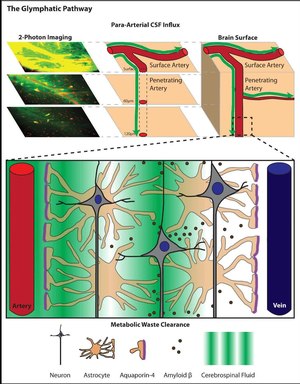Glymphatic system
| Glymphatic System | |
|---|---|
|
Mammalian glymphatic system
|
|
|
Anatomical terminology
[]
|
| Glymphatic System | |
|---|---|

Astrocytes stained for GFAP (green) and aquaporin-4 (purple)
|
|
|
Anatomical terminology
[]
|
The glymphatic system (or glymphatic clearance pathway) is a functional waste clearance pathway for the vertebrate central nervous system (CNS). The pathway consists of a para-arterial influx route for cerebrospinal fluid (CSF) to enter the brain parenchyma, coupled to a clearance mechanism for the removal of interstitial fluid (ISF) and extracellular solutes from the interstitial compartments of the brain and spinal cord. Exchange of solutes between the CSF and the ISF is driven by arterial pulsation and regulated during sleep by the expansion and contraction of brain extracellular space. Clearance of soluble proteins, waste products, and excess extracellular fluid is accomplished through convective bulk flow of the ISF, facilitated by astrocytic aquaporin 4 (AQP4) water channels.
The name "glymphatic system" was coined by the Danish neuroscientist Maiken Nedergaard in recognition of its dependence upon glial cells and the similarity of its functions to those of the peripheral lymphatic system.
While glymphatic flow was initially believed to be the complete answer to the long-standing question of how the sensitive neural tissue of the CNS functions in the perceived absence of a lymphatic drainage pathway for extracellular proteins, excess fluid, and metabolic waste products, two subsequent articles by Louveau et al. from the University of Virginia School of Medicine and Aspelund et al. from the University of Helsinki reported independently the discovery that the dural sinuses and meningeal arteries are in fact lined with conventional lymphatic vessels, and that this long-elusive vasculature forms a connecting pathway to the glymphatic system.
...
Wikipedia

